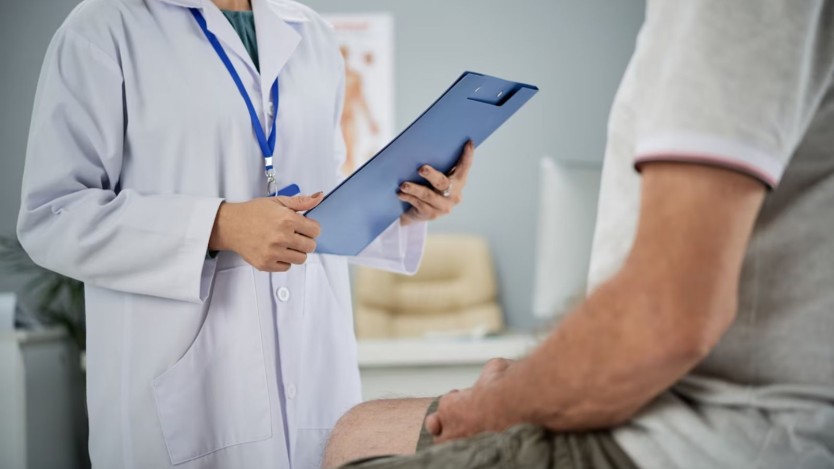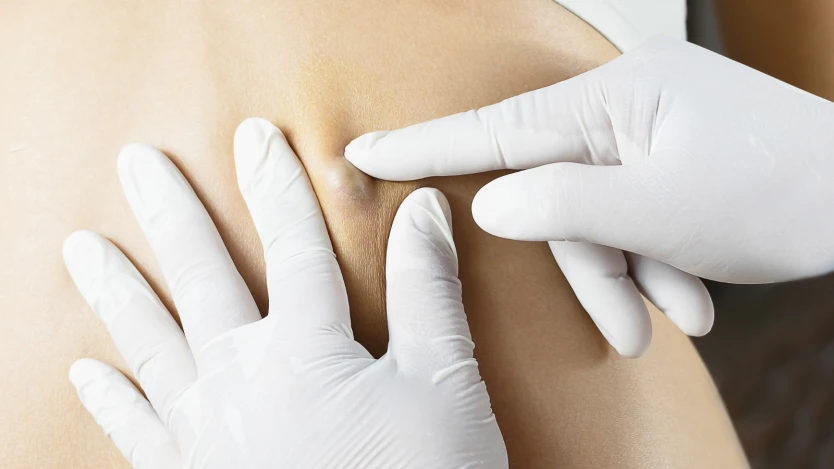Abdominal lipoma, what it is, causes and treatments

- What is abdominal lipoma?
- Causes of abdominal lipoma
- Symptoms of abdominal lipoma
- Diagnosis of abdominal lipoma
- Treatments of abdominal lipoma
What is abdominal lipoma?
- Lipomas are benign tumours that can occur anywhere on the body, although they tend to appear particularly on the back, shoulders, neck and surface of the abdomen.
- These fat cells develop under the skin and appear as nodules, soft to the touch.
- Lipoma surgery is the most effective way to remove fatty nodules.
Abdominal lipomas are a frequent reason for medical consultation, so if you are reading this article, it is likely that you have developed one of these nodules known as a lipoma.
This is a lump made up of fatty tissue that is always found subcutaneously, i.e. under the skin.
Lipomas are commonly called benign tumours and appear in the form of soft nodules, usually located on the back, shoulders, neck and the surface of the abdomen.
Some of the factors that may be influencing the development of lipomas include obesity, alcohol consumption, injuries, etc.

There are different techniques to remove lipomas. However, surgery is the most effective way to achieve this.
An abdominal lipoma is a lump of fat located between the skin and the muscle layer. These nodules have a soft feel and a rounded shape and are covered with normal-looking skin.
Lipomas are not usually attached to deep levels of our body, i.e. they are located at a more superficial level, which is why you may notice how they move under our skin when you touch them.
In terms of size, lipomas can be as small as a lentil or, on the contrary, they can grow and reach a considerable size, as well as being visible to the naked eye.
We speak of lipomatosis when the lipomas are multiple and appear in large groups.
These fatty lumps can appear from the age of 20 to 25 years, although they are more common in people between 40 and 60 years of age and very rare in children. Also, with age, the number of lipomas in the body may increase.
Causes of abdominal lipoma
Although the exact causes of abdominal lipomas are unknown, there are some risk factors that may influence their development.
- Hereditary factors: although a lipoma is not hereditary in origin, it is true that lipomatosis does have a high hereditary component.
- Obesity: these fatty lumps may be related to the patient's weight gain, although there are no conclusive studies to confirm this.
- Gender: women are more likely to suffer from abdominal lipoma because they tend to accumulate fat in different parts of the body such as the thighs, breasts or abdomen. Lipomatosis, on the other hand, tends to be more common in men.
- Blows or injuries: Sometimes, a blow or injury can lead to the growth of a lipoma. The most common cases are on the thighs and legs, although they do not occur very often.
- Alcohol consumption: drinking alcohol may also increase a person's risk of developing lipomatosis.
- Medical conditions: liver disease or difficulty controlling blood sugar can increase the risk of abdominal lipoma.

Free Assessment for Contracting Medical Services
Operarme’s Patient Service will contact you and solve all your questions on the medical service you need.
Symptoms of abdominal lipoma
The symptoms experienced by a patient suffering from lipomas depend, above all, on where they are located. However, these fatty nodules are not usually associated with any bothersome symptoms.
Some of the characteristics of abdominal lipomas are as follows:
- They are located under the skin
- They are soft and move easily when pressure is put on them.
- Some are painful, especially those that are larger and close to nearby nerves or if they have many blood vessels.
Abdominal lipomas can become infected, producing an increase in size and reddening of the skin.
In these cases the administration of antibiotics may be necessary to control the infection, although it is best to visit a specialist.
Diagnosis of abdominal lipoma
In order to rule out that an abdominal lipoma is a malignant tumour, it is essential to see a specialist, who will confirm or reject the diagnosis

Thus, the specialist may perform various examinations and medical tests on the patient to diagnose the abdominal lipoma:
- Initial interview to find out the clinical history.
- Physical examination (palpation) of the abdominal lipoma.
- Ultrasound or other imaging test. In cases where the lipoma has reached a considerable size, magnetic resonance imaging is performed to get a good understanding of its location and limits.
- Biopsy, a test in which a small sample of tissue is removed, may be performed to analyse the lipoma.
Although abdominal lipomas appear at any age, they are more common in people between 40 and 60 years of age.
If you would like to request a free consultation with a specialist in General Surgery, you can fill in our contact form, call at +34 91 141 33 56 so that our patient service team can explain the procedure and make an appointment for you:

Do you need to remove an abdominal lipoma?
Request a free and immediate appointment with our specialists in General surgery
Treatments of abdominal lipoma
Although most lipomas do not require treatment, many are likely to be painful, grow too large or limit a person's mobility and need to be surgically removed.
In these cases, the main methods for removing a lipoma are:
- Liposuction: through a suction procedure, the specialist removes the lipoma. Through an incision in the skin, the liposuctor is introduced and the tumour is suctioned out.
- Surgical removal
Surgical removal of an abdominal lipoma
Lipoma surgery is the most commonly used treatment to remove these benign tumours. It is a simple and safe operation in which the complete disappearance of the lipoma is guaranteed.
Lipoma surgery is the treatment to remove the lipoma definitively.
Broadly speaking, abdominal lipoma removal is performed as follows:
- First, the anaesthetist will administer the medication around the lipoma so that you do not feel any discomfort during the removal.
- Next, the specialist will make an incision in the skin and dissect out the lipoma in the abdomen.
- Finally, he or she will close the incision with a stitch.
Surgery for abdominal lipomas is simple and takes 30 - 40 minutes.
Once the intervention is finished, the specialist will give you a series of medical recommendations for the care of the surgical scar.
If you have a situation of abdominal lipomas and want to assess your case with a specialist, Operarme offers you a free surgical assessment consultation. In this way, the doctor will be able to determine that your case does not contraindicate surgery in any case.
To request a free initial consultation, click on the following image:

Do you have an abdominal lipoma and need surgery?
Request a free and immediate appointment with our specialists
Medical disclaimer: All the published content in Operarme is intended to disseminate reliable medical information to the general public, and is reviewed by healthcare professionals. In any case should this information be used to perform a diagnosis, indicate a treatment, or replace the medical assessment of a professional in a face to face consultation. Find more information in the links below:
